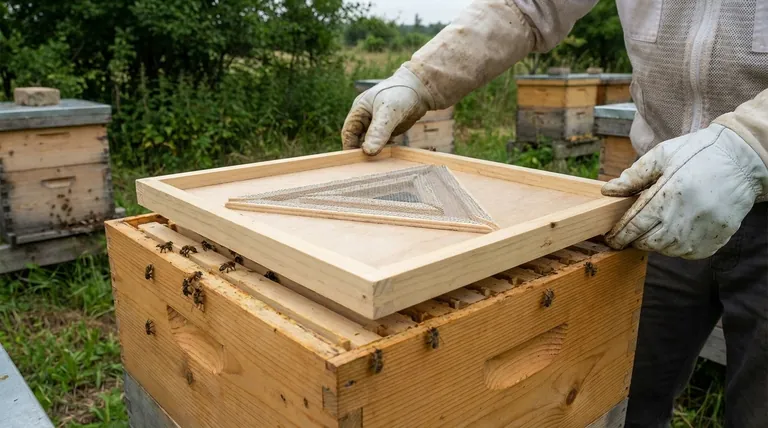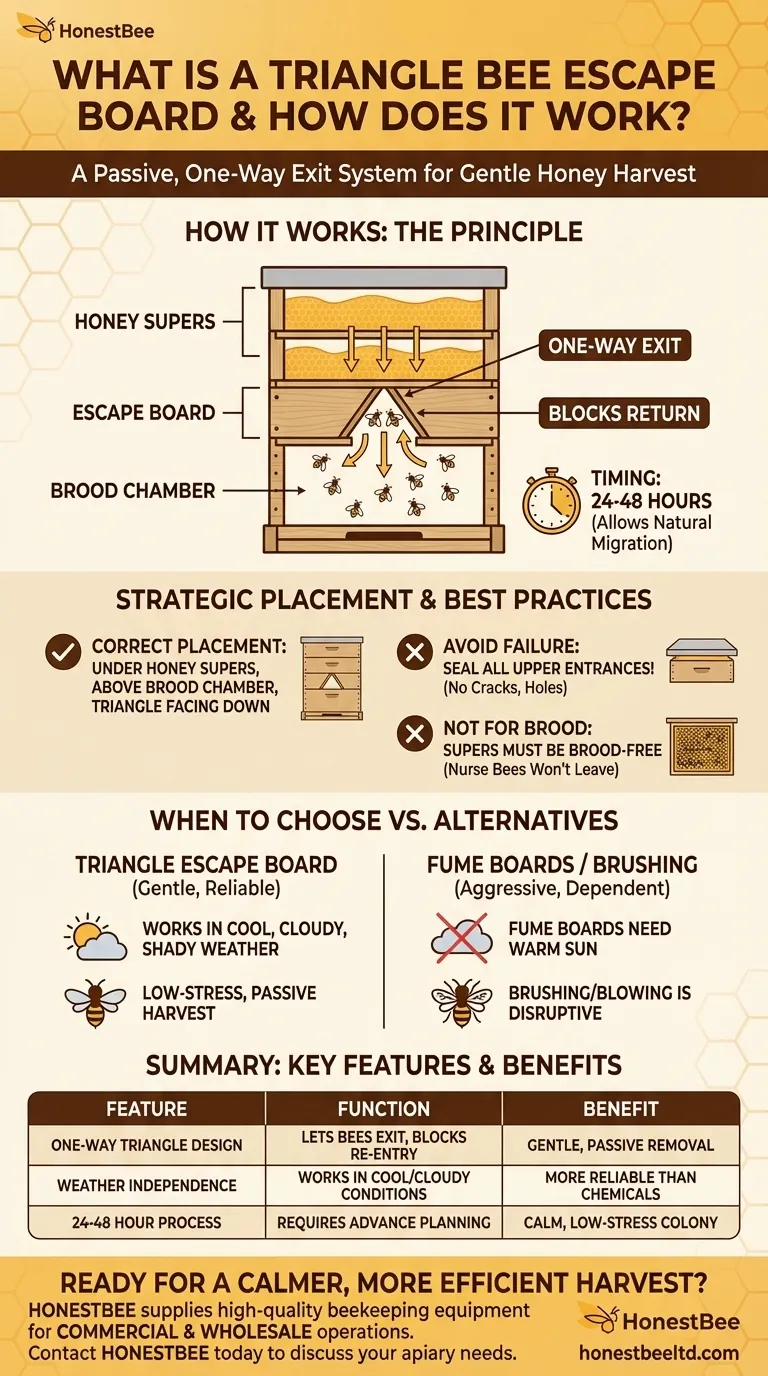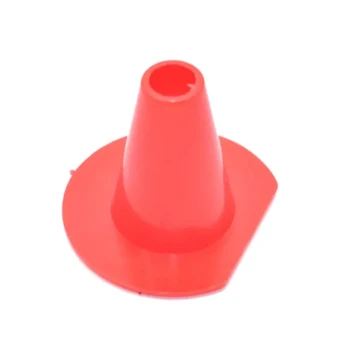A Triangle Bee Escape Board is a specialized tool used by beekeepers to clear bees out of honey supers before a harvest. It provides a passive, one-way exit system that allows bees to move down into the main hive body but prevents them from returning to the honey-filled frames, making the removal of supers significantly easier and less disruptive.
The core function of a Triangle Bee Escape Board is to gently and effectively separate your bees from the honey you intend to harvest. It's a time-based tool that prioritizes a calm hive over a speedy collection.

How a Triangle Bee Escape Board Works
The effectiveness of the escape board lies in its simple yet clever design, which leverages natural bee behavior.
The Principle of the One-Way Exit
The board contains a triangular-shaped plastic insert. Bees can easily move from the wide base of the triangle down into the brood chamber below.
However, when they attempt to return, they are met with the narrow point of the triangle. This small exit is difficult for them to find, effectively creating a one-way door that funnels them out of the honey supers.
Strategic Placement is Key
For the board to function correctly, it must be placed under the honey supers you plan to harvest and above the main hive body or brood chamber.
Crucially, the side with the triangle must face down towards the brood box. This orientation is what creates the one-way exit.
Timing for Optimal Results
This is not an instant solution. The board needs to be installed on the hive 24 to 48 hours before you plan to remove the supers. This gives the bees ample time to naturally migrate down and out of the honey boxes.
When to Choose a Triangle Escape Board
While other methods exist for clearing bees, the escape board is the ideal choice in specific scenarios.
An Excellent Alternative to Fume Boards
Fume boards, which use a chemical repellent to drive bees down, are highly dependent on warm, sunny weather to work effectively.
In shady, cool, or cloudy conditions, a Triangle Bee Escape Board is a far more reliable method for clearing your supers.
For a Gentler, Low-Stress Harvest
Methods like brushing bees off frames or using a bee blower can be aggressive and highly disruptive to the colony.
The escape board offers a passive, gentle alternative. The bees leave on their own schedule, which keeps the colony calm and makes the entire harvest process less stressful for both the bees and the beekeeper.
Understanding the Trade-offs and Best Practices
To use this tool effectively, you must be aware of its limitations and the common mistakes that can render it useless.
Ensure No Upper Entrances
The most common failure point is the presence of another exit above the escape board. If there are cracks, holes, or an upper entrance in the hive lid or supers, bees will simply use that path to re-enter the honey supers, completely defeating the purpose of the board.
Before installing the board, carefully inspect and seal off all potential entrances above it.
Not Suitable for Supers with Brood
The escape board relies on bees willingly leaving the supers. However, nurse bees will not abandon eggs, larvae, or capped brood.
If the queen has laid eggs in your honey supers, the bees will stay to care for the brood, and the board will not work. Ensure the supers you intend to clear are free of any brood.
The Main Cost is Time
The primary trade-off for this gentle method is time. Unlike brushing or blowing, you cannot decide to harvest and complete the task on the same day. Using an escape board requires planning at least one day in advance.
Making the Right Choice for Your Harvest
Use these guidelines to determine if a Triangle Bee Escape Board is the right tool for your specific goal.
- If your primary focus is a calm, low-stress harvest for your bees: This is the ideal tool, as it allows bees to move at their own pace without chemicals or force.
- If your primary focus is harvesting in cool or overcast weather: This board is more reliable than a fume board, which requires heat and sun to be effective.
- If your primary focus is speed and a same-day harvest: This is not the right tool; you should consider brushing frames or using a bee blower instead.
By understanding how and when to use this tool, you can ensure a smoother, more successful honey harvest.
Summary Table:
| Key Feature | Function | Benefit |
|---|---|---|
| One-Way Triangle Design | Lets bees exit but not re-enter honey supers. | Gentle, passive bee removal. |
| Weather Independence | Works effectively in cool, cloudy, or shady conditions. | More reliable than chemical repellents. |
| 24-48 Hour Process | Requires advance planning for installation. | Results in a calm, low-stress colony. |
Ready for a Calmer, More Efficient Harvest?
As a commercial beekeeper or distributor, your time and the health of your colonies are paramount. The HONESTBEE Triangle Bee Escape Board is designed to integrate seamlessly into your operation, ensuring a smooth, low-stress honey harvest that protects your valuable bees.
We supply high-quality, durable beekeeping supplies and equipment through wholesale-focused operations, helping you maximize productivity.
Contact HONESTBEE today to discuss your commercial or wholesale needs and discover how our equipment can benefit your apiary.
Visual Guide

Related Products
- HONESTBEE Wooden Bee Escape Board with Triangle Mesh Design for Beekeeping
- Professional Cone Style Bee Escape for Efficient Honey Harvesting
- Professional Durable Two-Piece Plastic Bee Escape
- HONESTBEE Multi Exit Plastic Bee Escape Board for Efficient Honey Harvesting
- Circular Labyrinth Bee Escape for Efficient Hive Management
People Also Ask
- What precautions should be taken when using the triangle escape board? Master Gentle Honey Harvesting
- What are the recommended conditions for using the triangle bee escape board? Ensure a Successful, Low-Stress Honey Harvest
- How is the Triangle Bee Escape Board placed when removing a super? Master the Correct Placement for a Stress-Free Harvest
- What is the effectiveness of the Bee Escape Board? Achieve a Calm, 95% Bee-Free Honey Harvest
- Are Triangular Escape Boards ready to use? Yes, and Here's How to Use Them Effectively



















